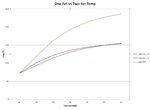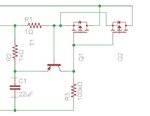Cval
Junior Member level 1
Hello,
I am having an issue with my PCB. The circuit is a current limiting circuit in which the limit threshold is controlled by R1. The output is to a motor spinning a wire which must stall at the specified current in order to prevent damage. The P-Mosfet is heating up when the motor is at or close to the stall limit. The heat isn’t damaging the FET, but it is affecting the other components (PNP) causing the specified stall current to drop from ~.6A to ~.3A.
I believe this is happening because the FET is not fully off as the motor is still drawing ~.6A when the stall limit is reached, which is what it was designed to do. I can change the FET if there is a spec that will improve the thermal stability, would this have to do with the FET’s switching characteristics? Would it be better to have a faster or slower switching time? Should I find a PNP trans that will be less effected by heat?
Thanks,
R1=1ohm
R2=1k
R3=100k
R4=82ohm (for a potentiometer)
C1=22uF
T1=P-Mosfet (**broken link removed**)
U1=PNP Trans (**broken link removed**)

I am having an issue with my PCB. The circuit is a current limiting circuit in which the limit threshold is controlled by R1. The output is to a motor spinning a wire which must stall at the specified current in order to prevent damage. The P-Mosfet is heating up when the motor is at or close to the stall limit. The heat isn’t damaging the FET, but it is affecting the other components (PNP) causing the specified stall current to drop from ~.6A to ~.3A.
I believe this is happening because the FET is not fully off as the motor is still drawing ~.6A when the stall limit is reached, which is what it was designed to do. I can change the FET if there is a spec that will improve the thermal stability, would this have to do with the FET’s switching characteristics? Would it be better to have a faster or slower switching time? Should I find a PNP trans that will be less effected by heat?
Thanks,
R1=1ohm
R2=1k
R3=100k
R4=82ohm (for a potentiometer)
C1=22uF
T1=P-Mosfet (**broken link removed**)
U1=PNP Trans (**broken link removed**)


